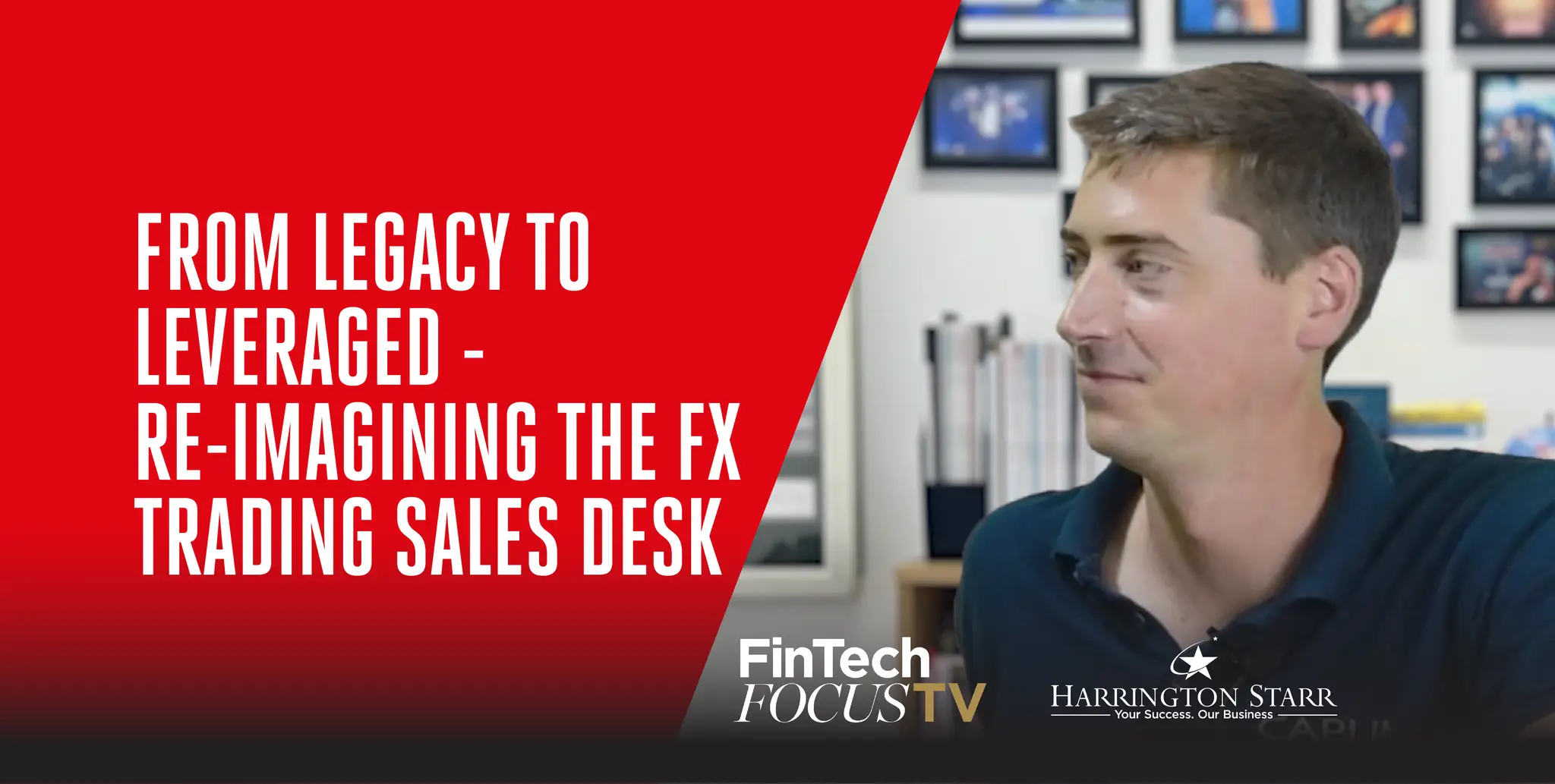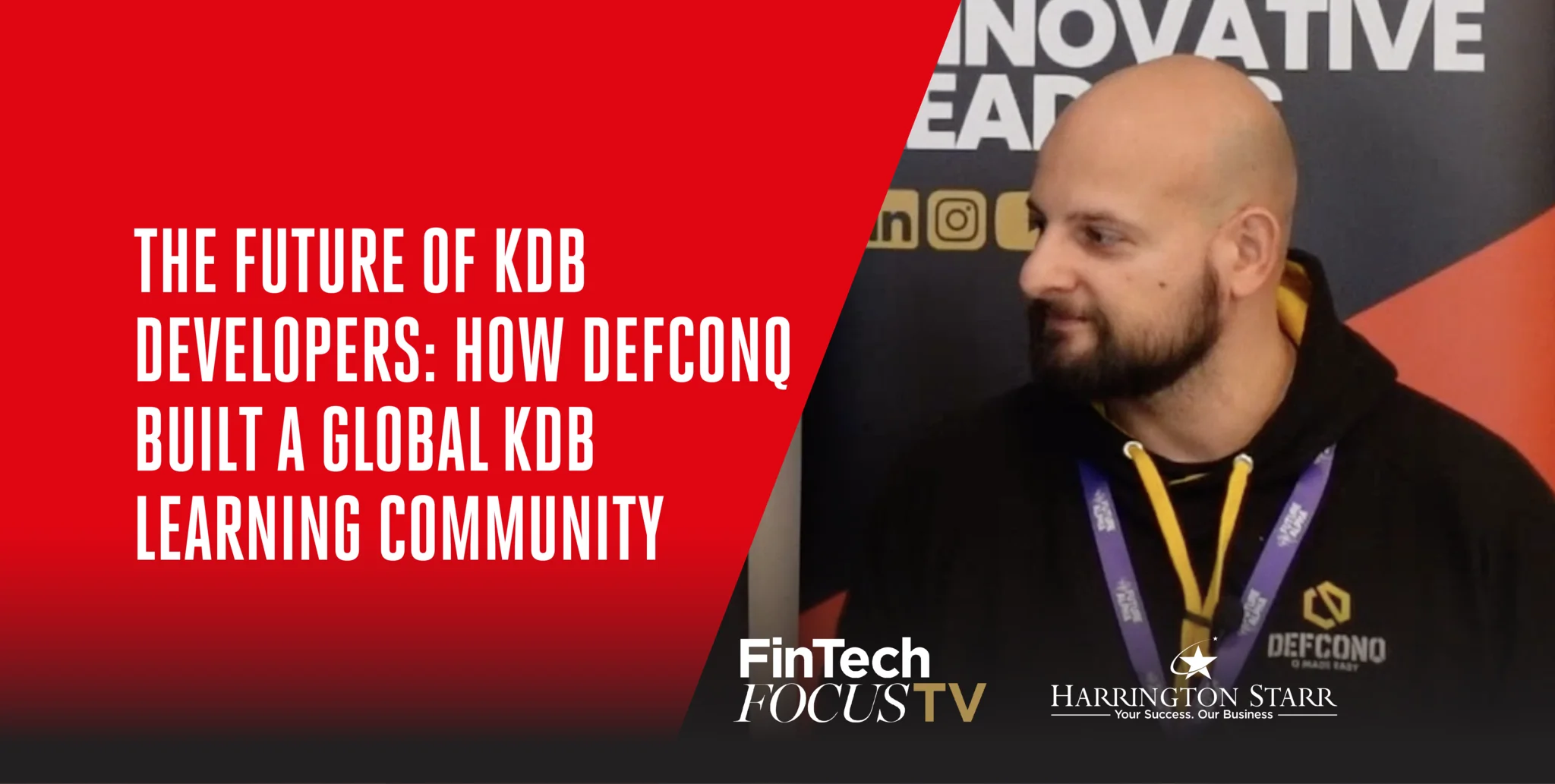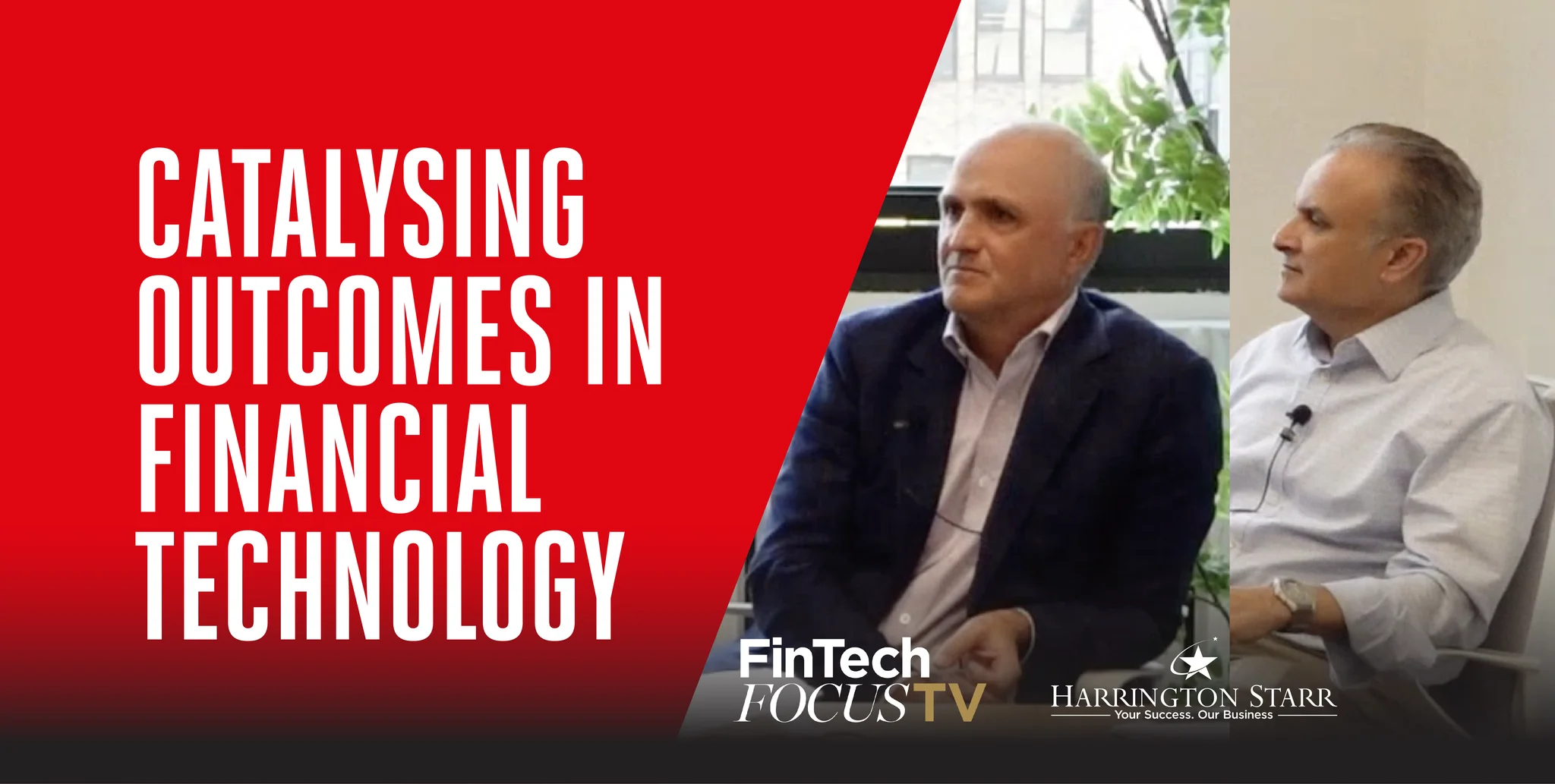Driving the Digital Evolution of Sales Desks
In this episode of FinTech Focus TV, Toby Babb is joined by Tom Darvall, Managing Director at Caplin Systems, for a deep dive into the evolution of trading technology, the transformation of sales desks, and the growing importance of user experience in capital markets infrastructure. The conversation explores how Caplin has helped shape the FinTech landscape since the early 2000s and how their latest innovations are empowering banks to overcome productivity challenges, modernise workflows, and prepare for a multi-asset, AI-enabled future.
As a FinTech recruitment firm with a strong track record of helping financial services businesses find the talent to drive innovation, Harrington Starr understands the value of technology leaders like Tom. His insight reflects a growing need for companies to align architecture, talent, and design thinking to meet the evolving expectations of clients, regulators, and employees alike.
From Low Latency Streaming to Full Trading Platforms: Caplin’s Foundation
Tom opens the discussion with an overview of Caplin’s origins. The company began in 2000, at a time when dial-up modems were the norm and low latency was a rare commodity. Caplin’s first major innovation was a high-performance data streaming product, designed to transmit FX tick data across the internet at speed. This caught the attention of tier-one banks, many of whom used the technology to stream live pricing data into trading applications and web browsers.
Caplin didn’t stop at solving the challenge of data delivery. They also focused on how to represent that data visually, becoming one of the pioneers in building web-based single-dealer platforms. Over time, the business evolved into offering a suite of front-end trading applications for a variety of user groups, including corporate clients, institutional traders, high-net-worth individuals, and internal teams such as sales, trading and back-office staff.
What ties these offerings together is Caplin’s commitment to intuitive design and efficient workflow. Every application they build is designed with usability at the core, ensuring that the trading experience is not only fast and reliable but also easy to navigate for end-users. This focus on user experience continues to shape their roadmap today.
The Shift from Voice to Electronic Trading
The conversation turns to a topic that is central to both Caplin’s business and broader FinTech transformation: the shift from voice trading to electronic trading. According to Tom, this trend has been gaining momentum for over a decade but has been significantly accelerated by three main factors: regulation, cost pressure, and cultural change.
Regulatory shifts, including MiFID II and updates to the Global Code, have introduced requirements around price transparency, trade reconstruction, and audit trails. These frameworks have essentially made traditional voice-based trading and informal note-taking obsolete. Banks must now ensure that all elements of trade execution are digitally documented and accessible.
In addition to regulation, Tom points to the economic reality of FX trading, where margins are increasingly thin. With revenue per trade declining, banks can no longer afford the manual overhead associated with traditional workflows. Automation has become critical, not just to reduce costs, but to maintain profitability.
Finally, Tom notes the cultural evolution taking place across capital markets. Much like in consumer banking, where customers now expect mobile-first, 24/7 service, institutional clients and internal stakeholders are demanding the same level of digital maturity. Sales teams, clients, and even operations staff expect a seamless, intuitive interface when engaging with trading platforms.
Empowering Sales Desks Through Workflow Innovation
One of the most powerful insights from this episode of FinTech Focus TV is Caplin’s approach to modernising the sales desk. As Tom explains, banks are increasingly recognising that it’s not enough to digitise the client journey; they must also digitise and enhance the internal user experience for their salespeople.
This starts with enabling self-service for low-touch, low-value trades. By pushing routine transactions through digital channels, banks can free up their sales teams to focus on more strategic, value-added interactions. But Caplin doesn’t stop there. They also believe the sales experience should mirror the standards expected by clients: easy, intuitive, and designed to boost productivity.
Tom shares a compelling example from a recent Caplin project involving a global bank with a team of 20 salespeople. By consolidating key information, such as customer data, margin information, and pricing, into a single screen, Caplin was able to reduce administrative overhead by an average of 1.5 hours per person, per day. Over time, this creates a significant productivity gain, allowing sales professionals to focus on solution selling, relationship development, and other high-impact activities.
Toby echoes this point, highlighting how productivity and efficiency are becoming critical themes across financial services. With limited headroom for cost-cutting, increasing productivity is one of the few remaining levers for growth.
Tackling Silos and Aligning Goals
The discussion moves on to a persistent challenge faced by many financial institutions: organisational and technological silos. Tom identifies this as a major obstacle to innovation, particularly when banks are looking to deliver consistent experiences across teams, products and geographies.
He recounts a case study where Caplin worked with a U.S.-based bank on a cross-border payments project. The initiative involved multiple departments, including treasury and FX, each with their own legacy systems, objectives, and requirements. By going back to basics and asking fundamental questions about business outcomes, user pain points and measurement criteria, Caplin was able to refocus the project and design a unified client experience.
This consultancy-led approach is part of Caplin’s value proposition. As Tom puts it, banks are not always software delivery experts. Vendors must take a proactive role in helping clients define goals, map out user journeys, and ensure that the technology supports long-term business value. In many cases, this involves acting as a partner rather than a supplier, a distinction that is becoming increasingly important in modern FinTech.
Beyond “Buy vs Build”: The Rise of the Tech Partnership
A theme that recurs throughout the interview is the changing nature of software procurement in financial services. The old binary of “build versus buy” is giving way to a hybrid approach where financial institutions are seeking modular, adaptable solutions that provide both control and speed.
Tom suggests that the desire for control is one of the main reasons banks historically chose to build their trading platforms. However, with the pace of change accelerating, the drawbacks of this approach are becoming clearer: long development timelines, inflexible architectures, and high maintenance costs.
Caplin’s solution is to offer technology that can be tailored and extended without compromising the upgrade path. Their platform supports “clean extension points”, allowing banks to customise features, user interfaces and workflows without losing access to future product updates.
This modularity is not only technically efficient but also aligns well with how banks want to manage risk. As Tom explains, decision-makers in financial institutions often take career risks when selecting long-term platforms. The ability to adapt and iterate over time, rather than being locked into a static solution, is a major advantage in today’s market.
Measuring What Matters: Redefining Productivity
Toby raises a critical question about how banks can measure the impact of sales desk modernisation. In response, Tom returns to the importance of productivity, not as an abstract metric, but as a driver of profitability. He argues that simply speeding up admin tasks isn’t enough. The real value lies in what salespeople do with the time they save.
Caplin has developed several features to support this vision, including a “text-to-ticket” capability that allows users to create trades using natural language input. By entering just a few words, client name, trade direction, currency pair and amount, salespeople can quickly generate tickets, reducing the need for repetitive data entry.
Beyond efficiency, Caplin is also investing in decision support tools that use client trading data to surface cross-sell opportunities. For example, if a client requests an FX trade, the system might highlight relevant products in other asset classes. This requires not only high-quality data but also a platform that supports multiple asset classes in a single interface.
As Tom notes, banks are increasingly requesting support for fixed income, commodities, and money markets, reflecting a broader trend towards platform consolidation and cross-product selling.
Innovation vs Evolution: A Realistic Take on AI
No modern FinTech discussion would be complete without addressing artificial intelligence. Toby highlights the buzz around AI and the ongoing debate over whether the industry is experiencing true innovation or just incremental evolution.
Tom offers a pragmatic perspective. While acknowledging the headline-grabbing nature of AI, he believes the real innovation lies in how technology is being deployed to improve agility and user experience. For Caplin, this has meant re-architecting their platform into individual software components or “widgets” that can be updated independently.
This granular approach gives banks the ability to customise their user experience, accelerate time-to-value, and deploy upgrades without needing to overhaul entire systems. Tom compares this to a future “app store” model where banks can select, configure and deploy new features with the click of a button.
This modular architecture is a clear response to feedback from the front office, where salespeople want faster access to new capabilities and less friction in their day-to-day workflows. It also supports the broader goals of modern FinTech hiring, placing emphasis on agility, adaptability and speed of delivery.
The Future: Multi-Asset Expansion and Digital Asset Readiness
Looking ahead, Tom reveals that Caplin is actively expanding beyond its traditional FX roots. Demand is growing for trading tools that support fixed income, commodities, and money markets, as well as digital assets. Given that digital assets often trade like FX, this is a logical progression for the platform.
Tom acknowledges that digital assets remain a controversial area, but insists that the underlying technology, particularly blockchain, is here to stay. Institutional and governmental adoption is on the rise, and Caplin intends to play a role in shaping how these markets are accessed and managed.
Another key area of focus is simplifying the technology experience. Caplin’s long-term vision is to offer a self-service platform where banks can log in, select the modules they need, and deploy them with ease. This vision ties back to their foundational principle: making trading as efficient, intuitive, and effective as possible.
Conclusion: A Blueprint for FinTech Transformation
In closing the episode, Toby asks Tom who should be speaking to Caplin right now. Tom’s answer is clear: any global or regional bank that wants to increase trading desk efficiency, improve client experience, or support a broader range of financial products should reach out. Caplin is ready to partner with firms looking to deliver scalable, user-centric platforms that evolve with the needs of the business.
For FinTech hiring managers, product owners, and technology leaders, this episode of FinTech Focus TV offers a wealth of practical insights. It highlights the importance of productivity, user experience, and agile architecture in today’s trading environment and provides a blueprint for how to move from legacy processes to future-ready platforms.
As a leading FinTech recruitment business, Harrington Starr remains committed to supporting firms that are rethinking how financial services should work, from technology to talent, from regulation to relationships. Tom Darvall’s conversation with Toby Babb is a timely reminder that the best innovations in FinTech are those that empower people, simplify complexity, and deliver meaningful value.






